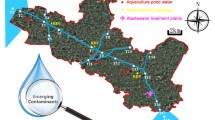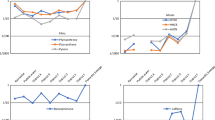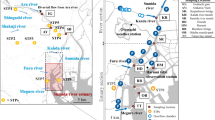Abstract
The presence of emerging compounds was investigated in surface water samples from Iguassu River watershed in the metropolitan region of Curitiba (Brazil). Emerging compounds are substances present in domestic and industrial sewage. Generally, the emerging compounds are present in the environment due to the indiscriminate release of untreated domestic and industrial sewage. Even treated sewage may contain emerging compounds due to the difficulty in removing them. In this work, the presence of caffeine, musk xylene (a fragrance), and bisphenol-A was investigated in surface water samples. Also, traditional parameters used in water quality monitoring were determined, such as biochemical oxygen demand (BOD), nitrate, and fecal coliforms. The emerging compounds were extracted in solid phase and analyzed by high performance liquid chromatography. Caffeine is eliminated in the urine (approximately 0.5% to 10% of the consumption), and the only source is domestic sewage. Bisphenol is widely used in food packs, while musk xylene is found in personal care products, easily eliminated in sewage. The caffeine concentration was between 1.74 ± 0.54 and 123.45 ± 0.81 µg/L. Musk xylene and bisphenol-A had their concentrations between 0.04 ± 0.07 and 0.56 ± 0.12 and between 0.62 ± 0.15 and 12.61 ± 0.21 µg/L, respectively. Positive correlations were found between caffeine and traditional monitoring parameters (BOD and fecal coliforms). Higher values of emerging compounds were determined at points considered extremely polluted. The positive correlations confirm the origin of emerging compounds and show that chemical markers are good parameters for monitoring pollution when the use of traditional parameters makes the diagnosis doubtful.


Similar content being viewed by others
References
APHA. (1998). Standard methods for the examination of water and wastewater (20th ed.). Washington DC: American Public Health Association American Water Works Association/Water Environment Federation.
Arnaud, M. J. (1993). Metabolism of caffeine and other components of coffee. In S. Guaratini (Ed.), Caffeine, coffee and health (pp. 43–95). New York: Raven.
Aschmann, S. M., Arey, J., Atkinson, R., & Simonich, S. L. (2001). Atmospheric life times and fates of selected fragrance materials and volatile model compounds. Environmental Science & Technology, 35, 3595–3600.
Aufdenkampe, A. K., Arscott, D. B., Dow, C. L., & Standley, L. J. (2006). Molecular tracers of soot and sewage contamination in streams supplying New York City drinking water. Journal of the North American Benthological Society, 25(4), 928–953.
Barber, L. B., Leeheer, J. A., Pereira, W. E., Noyes, T. L., Brown, G. K., & Tabor, C. F. (1995). Organic compounds in sewage-derived contaminants. In R. H. Meade (Ed.), Contaminants in the Mississippi River, 1997–1992 (pp. 115–135). Reston: USGS Circular 1133.
Bester, K., Hüffmeyer, H., Schaub, E., & Klasmeier, J. (2008a). Surface water concentrations of the fragrance compound OTNE in Germany—a comparison between data from measurements and models. Chemosphere, 73(8), 1366–1372.
Bester, K., Klasmeier, J., & Kupper, T. (2008b). Emissions of OTNE (Iso-E-super) mass flows in sewage treatment plants. Chemosphere, 71(11), 2003–2010.
Buerge, I. J., Poiger, T., Müller, M. D., & Buser, H. R. (2003). Caffeine, an anthropogenic marker for wastewater contamination of surface waters. Environmental Science & Technology, 37(4), 691–700.
Chen, M. Y., Ike, M., & Fujita, M. (2002). Acute toxicity, mutagenicity, and estrogenicity of bisphenol-A and other bisphenols. Environmental Toxicology, 17(1), 80–86.
Chen, T. C., Shue, M. F., Yeh, Y. L., & Kao, T. J. (2009). Bisphenol A occurred in Kao-Pin River and its tributaries in Taiwan. Environmental Monitoring Assessment. doi:10.1007/s10661-008-0733-4.
Danzl, E., Sei, K., Soda, S., Ike, M., & Fujita, M. (2009). Biodegradation of Bisphenol A, Bisphenol F and Bisphenol S in seawater. International Journal of Environmental Research and Public Health, 6, 1472–1484.
Froehner, S., Machado, K. S., & Souza, D. B. (2009a). Tracking anthropogenic inputs in Barigui River-Brazil using biomarkers. Environmental Monitoring Assessment. doi:10.1007/s11270-009-0220-8.
Froehner, S., Martins, R. F., & Errera, M. R. (2009b). Assessment of fecal sterols in Barigui River sediments in Curitiba, Brazil. Environmental Assessment Monitoring, 157(1–4), 591–600.
Fromme, H., Küchler, T., Otto, T., Pilz, K., Müller, J., & Wenzel, A. (2002). Occurrence of phthalates and bisphenol A and F in the environment. Water Research, 36(6), 1429–1438.
Fu, J., Xiong, Y., Sheng, G., & Zeng, X. (2005). Determination of polycyclic musks in sewage sludge from Guangdong, China using GC–EI-MS. Chemosphere, 60(6), 817–823.
IBAMA (2000) Directive 357/2000. Water classification for uses. Brazilian Institute of Environment. www.ibama.gov.br. Accessed November 2009.
Kang, J. H., & Kondo, F. (2002). Bisphenol A degradation by bacteria isolated from river water. Archives of Environmental Contamination and Toxicology, 43, 265–269.
Klecka, G. M., Gonsior, S. J., West, R. J., Goodwin, P. A., & Markham, D. A. (2001). Biodegradation of bisphenol-A in aquatic environments: River die-away. Environmental Toxicology and Chemistry, 20, 2725–2735.
Kolpin, D. W., Furlong, E. T., Meyer, M. T., Thurman, M., Zaugg, S. D., Barber, L. B., et al. (2002). Pharmaceutical, hormones, and other organic wastewater contaminants in U.S. streams, 1999–2000: A national reconnaissance. Environmental Science & Technology, 36(6), 1202–1211.
Leeming, R., & Nichols, P. (1996). Concentrations of coprostanol that correspond to existing bacterial indicator guideline limits. Water Research, 30(12), 2997–3006.
Papadopoulou-Mourkidou, E., Patsias, J., Papadakis, E., & Koukourikou, A. (2001). Use of an automated on-line SPE HPLC method to monitor caffeine and selected aniline and phenol compounds in aquatic systems of Macedonia-Thrace. Greece. Fresenius' Journal of Analytical Chemistry, 371(4), 491–496.
Sankararamakrishnan, N., & Guo, Q. (2005). Chemical tracers as indicator of human fecal coliforms at storm water outfalls. Environment International, 31(8), 1133–1140.
Simonich, S. L., Begley, W. M., Debaere, G., & Eckhoff, W. S. (2000). Trace analysis of fragrance materials in wastewater and treated wastewater. Environmental Science & Technology, 34(6), 959–965.
Standley, L. J., Kaplan, L. A., & Smith, D. (2000). Molecular tracers of organic matter sources to surface water resources. Environmental Science Technology, 34(15), 3124–3130.
Staples, C. A., Dorn, P. B., Klecka, G. M., O’Block, S. T., & Harris, L. R. (1998). A review of the environmental fate, effects, and exposures of bisphenol A. Chemosphere, 36(10), 2149–2173.
Suzuki, T., Nakagawa, Y., Takano, I., Yaguchi, K., Yasuda, K. (2004) Environmental Fate of Bisphenol-A and its Biological metabolites in River Water and their Xeno-estrogenic Activity. Environmental Science Technology 38, 2389–2396.
Ternes, T. A., Stumpf, M., Mueller, J., Haberer, K., Wilken, R. D., & Servos, M. (1999). Behavior and occurrence of estrogens in municipal sewage treatment plants. Investigations in Germany, Canada and Brazil. The Science of the Total Environment, 225(1), 81–90.
Thomas, K. V., & Hilton, M. J. (2003). Determination of selected human pharmaceuticals compounds in effluent and surface water samples by HPLC-ESI-MS. Journal of Chromatography A, 1015(1–2), 129–141.
van de Plassche, E. J., & Balk, F. (1997). Environmental risk assessment of the polycyclic musks AHTN and HHCB according to the EU-TGD. Bilthoven, The Netherlands: National Institute of Public Health and the Environment (RIVM).
Vom Saal, F. S., & Hughes, C. (2005). An extensive new literature concerning low-dose effects of bisphenol A shows the need for a new risk assessment. Environmental Health Perspectives, 113(8), 926–933.
Yang, J. J., & Metcalf, C. D. (2006). Fate of synthetic musks in a domestic wastewater treatment plant and in an agricultural field amended with biosolids. The Science of the Total Environment, 363(1–3), 149–165.
Yunker, M. B., Macdonald, R. W., Vingarzan, R., Mitchell, R. H., Goyette, D., & Sylvestre, S. (2002). PAHs in the Fraser River basin: A critical appraisal of PAH ratios as indicators of PAH source and composition. Organic Geochemistry, 33(4), 489–515.
Acknowledgments
The study was made possible by financial support from the CNPq (Conselho Nacional de Desenvolvimento Científico e Tecnológico; Project 577060/2008-2 and 473238/2008-0). We are very grateful to Prof. Cristovão Scapulatempo Fernandes for the helpful discussions. We also would like to thank Mr. Luis Carlos Barbosa for the help in field works.
Author information
Authors and Affiliations
Corresponding author
Rights and permissions
About this article
Cite this article
Froehner, S., Machado, K.S., Falcão, F. et al. Inputs of Domestic and Industrial Sewage in Upper Iguassu, Brazil Identified by Emerging Compounds. Water Air Soil Pollut 215, 251–259 (2011). https://doi.org/10.1007/s11270-010-0475-0
Received:
Accepted:
Published:
Issue Date:
DOI: https://doi.org/10.1007/s11270-010-0475-0




